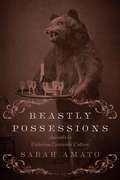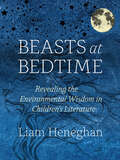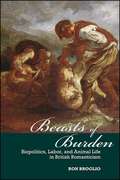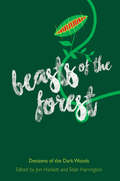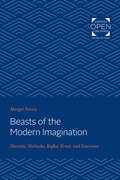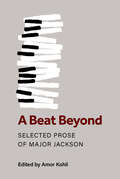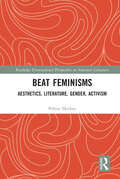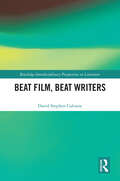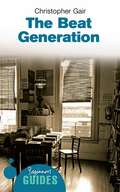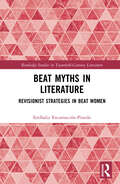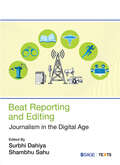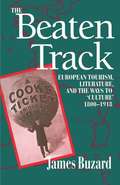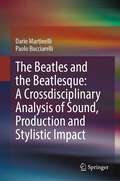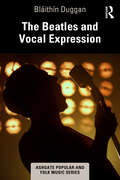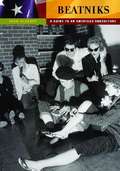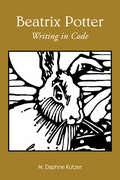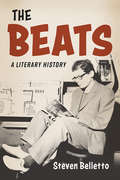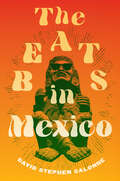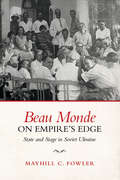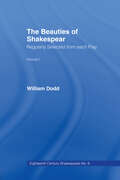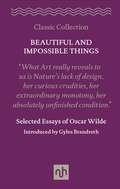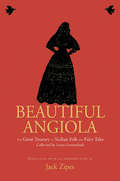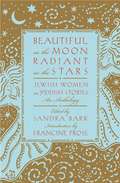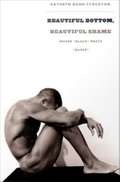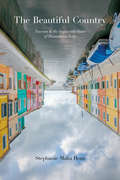- Table View
- List View
Beastly Possessions
by Sarah AmatoIn Beastly Possessions, Sarah Amato chronicles the unusual ways in which Victorians of every social class brought animals into their daily lives. Captured, bred, exhibited, collected, and sold, ordinary pets and exotic creatures - as well as their representations - became commodities within Victorian Britain's flourishing consumer culture.As a pet, an animal could be a companion, a living parlour decoration, and proof of a household's social and moral status. In the zoo, it could become a public pet, an object of curiosity, a symbol of empire, or even a consumer mascot. Either kind of animal might be painted, photographed, or stuffed as a taxidermic specimen.Using evidence ranging from pet-keeping manuals and scientific treatises to novels, guidebooks, and ephemera, this fascinating, well-illustrated study opens a window into an underexplored aspect of life in Victorian Britain.
Beasts at Bedtime: Revealing the Environmental Wisdom in Children's Literature
by Liam Heneghan“[A] fresh new look at animal tales, often classic, and how they pertain to the present-day and our often fraught relationship to our environment.” —Jeff VanderMeer, author of the Southern Reach TrilogyTalking lions, philosophical bears, very hungry caterpillars, wise spiders, altruistic trees, companionable moles, urbane elephants: this is the magnificent menagerie that delights our children at bedtime. Within the entertaining pages of many children’s books, however, also lie profound teachings about the natural world that can help children develop an educated and engaged appreciation of the dynamic environment they inhabit.In Beasts at Bedtime, scientist (and father) Liam Heneghan examines the environmental underpinnings of children’s stories. From Beatrix Potter to Harry Potter, Heneghan unearths the universal insights into our inextricable relationship with nature that underlie so many classic children’s stories. Some of the largest environmental challenges in coming years—from climate instability, the extinction crisis, freshwater depletion, and deforestation—are likely to become even more severe as this generation of children grows up. Though today’s young readers will bear the brunt of these environmental calamities, they will also be able to contribute to environmental solutions if prepared properly. And all it takes is an attentive eye: Heneghan shows how the nature curriculum is already embedded in bedtime stories, from the earliest board books like The Rainbow Fish to contemporary young adult classics like The Hunger Games.This book enthralls as it engages. Beasts at Bedtime will help parents, teachers, and guardians extend those cozy times curled up together with a good book into a lifetime of caring for our planet.“Beasts at Bedtime is proof that most kidlit has teachable moments embedded in it.” —Toronto Star
Beasts of Burden: Biopolitics, Labor, and Animal Life in British Romanticism (SUNY series, Studies in the Long Nineteenth Century)
by Ron BroglioIn Beasts of Burden, Ron Broglio examines how lives—human and animal—were counted in rural England and Scotland during the Romantic period. During this time, Britain experienced unprecedented data collection from censuses, ordinance surveys, and measurements of resources, all used to quantify the life and productivity of the nation. It was the dawn of biopolitics—the age in which biological life and its abilities became regulated by the state. Borne primarily by workers and livestock, nowhere was this regulation felt more powerfully than in the fields, commons, and enclosures. Using literature, art, and cultural texts of the period, Broglio explores the apparatus of biopolitics during the age of Adam Smith and Thomas Malthus. He looks at how data collection turned everyday life into citizenship and nationalism and how labor class poets and artists recorded and resisted the burden of this new biopolitical life. The author reveals how the frictions of material life work over and against designs by the state to form a unified biopolitical Britain. At its most radical, this book changes what constitutes the central concerns of the Romantic period and which texts are valuable for understanding the formation of a nation, its agriculture, and its rural landscapes.
Beasts of the Forest: Denizens of the Dark Woods
by Jon Hackett and Seán HarringtonAn interdisciplinary engagement with the forest and its monsters through critical readings of folklore, fiction, film, music video and animation.Within the text there are a multitude of convergent critical perspectives used to engage and explore fictional and real monsters of the forest in media and folklore. The collection features chapters from a variety of academic perspectives: film and media studies, cultural studies, queer theory, Tolkien studies, mythology and popular music are featured. Under examination are a wide range of narratives and media forms that represent, reimagine and create the werewolves, witches and weird apparitions that inhabit the forest, along with the forest as a monstrous entity in itself.Whether they be our shelter and safe-haven or the domain of malevolent spirits and sprites, forests have the capacity to horrify and threaten those that venture into them without permission. Human interference has continually threatened forests across the world, yet this threat is reversed in myth, folklore and more recent cultural forms. This collection ranges widely to analyze how forests figure in contemporary culture, as well as the wider contexts in which such representations are inserted.
Beasts of the Modern Imagination: Darwin, Nietzsche, Kafka, Ernst, and Lawrence
by Margot NorrisOriginally published in 1985. Beasts of the Modern Imagination explores a specific tradition in modern thought and art: the critique of anthropocentrism at the hands of "beasts"—writers whose works constitute animal gestures or acts of fatality. It is not a study of animal imagery, although the works that Margot Norris explores present us with apes, horses, bulls, and mice who appear in the foreground of fiction, not as the tropes of allegory or fable, but as narrators and protagonists appropriating their animality amid an anthropocentric universe. These beasts are finally the masks of the human animals who create them, and the textual strategies that bring them into being constitute another version of their struggle. The focus of this study is a small group of thinkers, writers, and artists who create as the animal—not like the animal, in imitation of the animal—but with their animality speaking. The author treats Charles Darwin as the founder of this tradition, as the naturalist whose shattering conclusions inevitably turned back on him and subordinated him, the rational man, to the very Nature he studied. Friedrich Nietzsche heeded the advice implicit in his criticism of David Strauss and used Darwinian ideas as critical tools to interrogate the status of man as a natural being. He also responded to the implications of his own animality for his writing by transforming his work into bestial acts and gestures. The third, and last, generation of these creative animals includes Franz Kafka, the Surrealist artist Max Ernst, and D. H. Lawrence. In exploring these modern philosophers of the animal and its instinctual life, the author inevitably rebiologizes them even against efforts to debiologize thinkers whose works can be studied profitably for their models of signification.
A Beat Beyond: Selected Prose of Major Jackson (Poets On Poetry)
by Major JacksonIn this collection of essays, interviews, and notes, Major Jackson revels in the work of poetry not only to limn and assess the intellectual and spiritual dimensions of poets, but to amplify the controversies and inner conflicts that define our age: political unrest, climate crises, the fallout from bewildering traumas, and the social function of the art of poetry itself. Accessible and critically minded, Jackson returns to the poem as an unparalleled source of linguistic pleasure that structures a multilayered “lyric self.” In his interviews, Jackson illustrates poetry’s distinct ability to mediate the inexplicable while foregrounding the possibilities of human song. Collected over several decades, these essays find Jackson praising mythmaking in Frank Bidart and Ai’s poetry, expressing bafflement at the silence of white-identified poets in the cause of social and racial justice, unearthing the politics behind Gwendolyn Brooks’s Pulitzer Prize, and marveling at the “hallucinatory speed of thought” in a diverse range of poets including Mei-mei Berssenbrugge, Brenda Hillman, Afaa Michael Weaver, Forrest Gander, and Terrance Hayes. This collection passionately surveys the radical shifts of the art and notes poetry as a necessity for a modern sensibility.
Beat Feminisms: Aesthetics, Literature, Gender, Activism (Routledge Transnational Perspectives on American Literature)
by Polina MackayThis is the first book-length study to read women of the Beat Generation as feminist writers. The book focuses on one author from each of the three generations that comprise the groups of female writers associated with the Beats – Diane di Prima, ruth weiss and Anne Waldman – as well as on experimental and multimedia artists, such as Laurie Anderson and Kathy Acker, who have not been read through the prism of Beat feminism before. Beat Feminisms argues that these writers’ feminism evolved over time, but retained a focus on intertextuality, on visions of transformation, on revisions of patriarchal discourses, on gender and on interventionist poetics within the context of activism. The book shows how these Beat feminisms counteract the ways in which women have been undermined, possessed or silenced.
Beat Film, Beat Writers (Routledge Interdisciplinary Perspectives on Literature)
by David Stephen CalonneBeat Film, Beat Writers is the first monograph to analyze the films of Christopher Maclaine, Lawrence Jordan, ruth weiss, Ron Rice, Robert Frank, Barbara Rubin, Shirley Clarke, William S. Burroughs, and Joanne Kyger. The book is noteworthy for its emphasis on women filmmakers who have traditionally been excluded from close analysis by film scholars. Beat Film, Beat Writers also explores the ways Beat authors such as Philip Lamantia, Michael McClure, Diane di Prima, Wiliam S. Burroughs, Allen Ginsberg, Jack Kerouac, Peter Orlovsky, Gregory Corso, Joanne Kyger, and others became deeply involved with the film communities of New York and California. The book discusses their roles as both actors and participants in the making of these films and demonstrates how many of the same themes that characterized Beat literature surface in cinema. The anxiety over the possibilities of nuclear war, the search for deeper modes of spirituality in the study of Buddhism as well as occult and esoteric systems, the struggle for equality for the LGBTQ+ community, the beginnings of the ecological movement, and the fight against censorship and the open depiction of sexuality are all themes that occur both in Beat film and in Beat literature. Beat Film, Beat Writers also features an Epilogue on the cinema of singer and poet Jim Morrison, who, although not part of the Beat movement, was deeply influenced by Beat literature and carried on many of the aesthetic and philosophical aims of the Beats into the late sixties.
The Beat Generation: A Beginner's Guide (Beginner's Guides)
by Christopher GairThe engine behind the first modern counterculture, the Beat Generation were a revolutionary group of American writers in the late 50s and early 60s who fused a fresh approach to literature with a bohemian lifestyle. Immortalized through Kerouac's On the Road and Ginsberg's Howl, their relaxed, gritty, and candid writing has inspired generations. Chronicling the group's origins, adventures, and inner workings, Gair introduces iconic personalities including Ginsberg, Kerouac, and Burroughs, along with women writers, musicians, and artists. Examining their monumental influence upon popular culture from bebop to the Beastie Boys, Gair proves beyond any doubt that their revolutionary approach to literature and life has created a key movement in American literature. Christopher Gair is Senior Lecturer in American Literature at the University of Glasgow in the United Kingdom.
Beat Myths in Literature: Revisionist Strategies in Beat Women (Routledge Studies in Twentieth-Century Literature)
by Estíbaliz Encarnación-PinedoBeat Myths in Literature reassesses the work of women poets associated with the Beat Generation from the critical lens of revisionist discourses. Using the metaphor and the critical lens of looking back, an act infused with feminist implications after Adrianne Rich (1972), the volume focuses on poetry, fiction, and autobiographical writing to analyze the different ways in which Beat women used revisionist discourses to refashion the Beat Generation and establish themselves as literary and artistic subjects. Offering the first comprehensive study of the use of mythology in the Beat Generation, Beath Myths in Literaute: Revisionist Strategies in Beat Women focuses on the specific re-writing or revisioning of mythical texts. As such, it studies the ways in which Beat poets incorporate mythology into their works, both through the feminist reinvention or appropriation of ancient myths, but also by debunking more contemporary myths used to contain women in particular social and artistic roles. Furthermore, this volume expands Rich’s notion of re-vision, considering memoirs and autobiographies as factual and fictional re-interpretations of history. Seen through the eyes of revisionist studies and the poets’ investment in “personal myth”, the book establishes new points of entrance into works that allow us to explore the feminist, political, and poetical relevance of the work of Beat women.
Beat Reporting and Editing: Journalism in the Digital Age
by Surbhi Dahiya Shambhu SahuFirst of its kind book to have extensive coverage of reporting, with a special focus on beat reporting. Beat Reporting and Editing: Journalism in the Digital Age offers an extensive and pioneering study of reporting for all the news beats, and news writing and editing. Besides having exclusive chapters on rural reporting, storytelling, photojournalism and cartooning, social media reporting, misinformation and fake news, and solution-based journalism, this coedited forty-eight-chapter textbook is an exhaustive resource filled with insights on traditional beats like defence, politics, court, crime, sports and entertainment. It covers all the emerging forms of journalism such as artificial intelligence (AI), blockchain and bots, podcast, mobile journalism (MOJO), drone journalism (DOJO) and data journalism in India. The book is structured to guide the students and teachers on the techniques of reporting on specific beats in the digital environment, role of AI and digital technologies in newsgathering and reportage as well as issues of identity, data, research and analysis in new-age journalism. Drawing on an enormous range of examples, case studies and first-hand experiences of eminent journalists and media educators, it encourages students to critically engage with all forms of journalistic writing in the digital era. Key Features: • First-of-its-kind textbook to include extensive coverage of reporting, with special focus on beat reporting • Not only limited to print media but also covers broadcast journalism as well as digital media • Contains chapters by highly experienced journalists who have worked in their specific beats for decades, and academicians teaching the subject in the classroom • One of the most future-ready textbooks on journalism featuring a whole section on innovations and emerging technologies in journalism
The Beaten Track: European Tourism, Literature, and the Ways to Culture, 1800-1918
by James BuzardThe Beaten Track is a major study of European tourism during the nineteenth century and the early years of the twentieth century. James Buzard demonstrates the ways in which the distinction between tourist and traveller has developed and how the circulation of the two terms influenced how nineteenth and twentieth-century writers on Europe viewed themselves and presented themselves in writing. Drawing upon a wide range oftexts from literature, travel writing, guidebooks, periodicals, and business histories, the book shows how a democratizing and institutionalizing tourism gave rise to new formulations about what constitutes `authentic' cultural experience. Authentic culture was represented as being in the secret precincts of the `beaten track' where it could be discovered only by the sensitive true traveller and not the vulgar tourist. Major writers such as Byron, Wordsworth, Frances Trollope, Dickens, Henry James, and Forster are examined in the light of the influential Murray and Baedeker guide books. This elegantly written book draws links with debates in cultural studies concerning the ideology of leisure and concludes that in this period tourism became an exemplary cultural practice appearing to be both popularly accessible and exclusive.
The Beatles and the Beatlesque: A Crossdisciplinary Analysis of Sound Production and Stylistic Impact
by Dario Martinelli Paolo BucciarelliThe Beatles and the Beatlesque address a paradox emanating from The Beatles’ music through a cross-disciplinary hybrid of reflections, drawing from both, musical practice itself and academic research. Indeed, despite their extreme stylistic variety, The Beatles’ songs seem to always bear a distinctive identity that emerges even more in similar works by other artists, whether they are merely inspired, derivative or explicitly paying homage. The authors, a musicologist and music producer, emphasize the importance of record production in The Beatles' music in a way that does justice not only to the final artifacts (the released songs) but also to the creative process itself (i.e., the songs "in the making").Through an investigation into the work of George Martin and his team, as well as The Beatles themselves, this text sheds light on the role of the studio in shaping the group's eclectic but unique sound. The chapters address what makes a song “Beatlesque”, to what extent production choices are responsible for developing a style, production being understood not as a mere set of technicalities, but also in a more conceptual way, as well as the aesthetics, semiotics and philosophy that animated studio activity. The outcome is a book that will appeal to both students and researchers, as well as, of course, musicophiles of all kinds.
The Beatles and Vocal Expression (Ashgate Popular and Folk Music Series)
by Bláithín DugganThe Beatles and Vocal Expression examines popular song through the topic of paralanguage – a sub-category of nonverbal communication that addresses characteristics of speech that modify meaning and convey emotion. It responds to the general consensus regarding the limitations of Western art music notation to analyse popular song, assesses paralinguistic voice qualities giving rise to expressive tropes within and across songs, and lastly addresses gaps in existing Beatles scholarship. Taking The Beatles’ UK studio albums (1963–1970), paralinguistic voice qualities are examined in relation to concepts, characteristics, metaphors, and functions of paralanguage in vocal performance. Tropes, such as rising and falling intonation on words of woe, have historical connections to performative and conversational techniques. This interdisciplinary analysis is achieved through musicology, sound studies, applied linguistics, and cultural history. The new methodology locates paralinguistic voice qualities in recordings, identifies features, shows functions, and draws aural threads within and across popular songs.
Beatniks: A Guide To An American Subculture
by Alan BisbortA historian of American culture and art, Bisbort profiles the first counter-culture generation to be branded by modern marketing. He describes the origins of the beat generation during World War II, how the beats turned into beatniks, the emergence of a beatnik voice, and the spread of the phenomenon from Manhattan to the US and the world. Support material includes a timeline, biographical sketches, a glossary, lists of movies and magazines, and lists of precursors and progeny. Annotation c2010 Book News, Inc., Portland, OR (booknews.com)
Beatrix Potter: Writing in Code (Children's Literature and Culture #27)
by M. Daphne KutzerBeatrix Potter was one of the inventors of the contemporary picture book, and her small novels published at the turn of the twentieth century are still available and popular today. Writing in Code is the first book-length study of Potter's work, and it covers the entire oeuvre, examining all facets of her work in relation to her private life. Daphne Kutzer reveals the depth of the symbolism in Potter’s work and relates this to the issues of the author's own development as an independent woman and writer, and her struggles with domesticity, Unitarianism, and the socio-political issues in late-19th and early-20th century England. Weaving the subtle themes inscribed in Potter's own stories with the concerns and temperament of the author who wrote them, Kutzer exemplifies literary criticism as it can illuminate the breadth of allusion in children's literature.
The Beats: A Literary History (Cambridge Companions To Literature Ser.)
by Steven BellettoKerouac. Ginsberg. Burroughs. These are the most famous names of the Beat Generation, but in fact they were only the front line of a much more wide-ranging literary and cultural movement. This critical history takes readers through key works by these authors, but also radiates out to discuss dozens more writers and their works, showing how they all contributed to one of the most far-reaching literary movements of the post-World War II era. Moving from the early 1940s to the late 1960s, this book explores key aesthetic and thematic innovations of the Beat writers, the pervasiveness of the Beatnik caricature, the role of the counterculture in the post-war era, the involvement of women in the Beat project, and the changing face of Beat political engagement during the Vietnam War era.
The Beats in Mexico
by David Stephen CalonneMexico features prominently in the literature and personal legends of the Beat writers, from its depiction as an extension of the American frontier in Jack Kerouac’s On the Road to its role as a refuge for writers with criminal pasts like William S. Burroughs. Yet the story of Beat literature and Mexico takes us beyond the movement’s superstars to consider the important roles played by lesser-known female Beat writers. The first book-length study of why the Beats were so fascinated by Mexico and how they represented its culture in their work, this volume examines such canonical figures as Kerouac, Burroughs, Ginsberg, Lamnatia, McClure, and Ferlinghetti. It also devotes individual chapters to women such as Margaret Randall, Bonnie Bremser, and Joanne Kyger, who each made Mexico a central setting of their work and interrogated the misogyny they encountered in both American and Mexican culture. The Beats in Mexico not only considers individual Beat writers, but also places them within a larger history of countercultural figures, from D.H. Lawrence to Antonin Artaud to Jim Morrison, who mythologized Mexico as the land of the Aztecs and Maya, where shamanism and psychotropic drugs could take you on a trip far beyond the limits of the American imagination.
Beau Monde on Empire’s Edge: State and Stage in Soviet Ukraine
by Mayhill FowlerIn Beau Monde on Empire’s Edge, Mayhill C. Fowler tells the story of the rise and fall of a group of men who created culture both Soviet and Ukrainian. This collective biography showcases new aspects of the politics of cultural production in the Soviet Union by focusing on theater and on the multi-ethnic borderlands. Unlike their contemporaries in Moscow or Leningrad, these artists from the regions have been all but forgotten despite the quality of their art. Beau Monde restores the periphery to the center of Soviet culture. Sources in Russian, Ukrainian, Polish, and Yiddish highlight the important multi-ethnic context and the challenges inherent in constructing Ukrainian culture in a place of Ukrainians, Russians, Poles, and Jews. Beau Monde on Empire’s Edge traces the growing overlap between the arts and the state in the early Soviet years, and explains the intertwining of politics and culture in the region today.
Beauties of Shakespeare Cb: Eighteenth Century Shakespeare Volume 9 - 2 Volumes
by William DoddFirst published in 2005. Routledge is an imprint of Taylor & Francis, an informa company.
Beautiful and Impossible Things: Selected Essays of Oscar Wilde
by Oscar Wilde Gyles BrandrethThis selection of Oscar Wilde’s writings provides a fresh perspective on his character and thinking. Compiled from his lecture tours, newspaper articles, essays and epigrams, these pieces show that beneath the trademark wit, Wilde was a deeply humane and visionary writer, as challenging today as he was in the late 1800s. This edition includes essays on interior design, prison reform, Shakespeare, the dramatic dialogue Decay of Lying and the seminal Soul of Man.
Beautiful Angiola: The Lost Sicilian Folk and Fairy Tales of Laura Gonzenbach
by Jack ZipesIn one of the most startling literary discoveries of recent years, Jack Zipes has uncovered this neglected treasure trove of Sicilian folk and fairy tales. Like the Grimm brothers before her, Laura Gonzenbach, a talented Swiss-German born in Sicily, set out to gather up the tales told and retold among the peasants. Gonzenbach collected wonderful stories - some on subjects that readers will know from the Grimms or Perrault, some entirely new - and published them in German. Her early death and the destruction of her papers in the Messina earthquake of 1908 only add to the mystery behind her achievement. Beautiful Angiola is an instant classic: a nineteenth-century collection of stories in the great tradition of fairy and folk tales now translated into English for the first time. Gonzenbach delights us with heroines and princes, sorcery and surprise, the deeds of the brave and the treacherous, and the magic of the true storyteller. The Green Bird , The Humiliated Princess , sorfarina , The Magic Cane, the Golden Donkey, and the Little Stick that Hits are titles destine to become new favourites for readers everywhere. Yet while the stories enchant us, the wry taglines with which they often end ('And so they remained rich and consoled, while we keep sitting here and are getting old') gently bring us back to earth.
Beautiful as the Moon, Radiant as the Stars: An Anthology
by Sandra BarkFor fans of Jonathan Safran Foer, Nathan Englander, Cynthia Ozick, and Anita Diamant comes one of the first collections of stories about Yiddish women writers. Written by both male and female writers, the stories in this anthology focus on the female Ashkenazic experience during the 19th and 20th centuries. The women in these fascinating, often shocking, stories range from rebellious daughters and reluctant brides to cunning businesswomen and vengeful midwives. The issues they face, while particular to their place in history, will still resonate with modern readers. Assimilation and anti-Semitism are hot-button debate topics; themes of love, family, and loss are universal. This extensive collection contains the original stories that inspired Fiddler on the Roof and Yentl; an early Yiddish story by Dvora Baron, the first modern Hebrew writer; a story by Isaac Bashevis Singer and one by his sister, Esther Singer Kreitman.
Beautiful Bottom, Beautiful Shame: Where "Black" Meets "Queer"
by Kathryn Bond StocktonShame, Kathryn Bond Stockton argues in Beautiful Bottom, Beautiful Shame, has often been a meeting place for the signs "black" and "queer" and for black and queer people--overlapping groups who have been publicly marked as degraded and debased. But when and why have certain forms of shame been embraced by blacks and queers? How does debasement foster attractions? How is it used for aesthetic delight? What does it offer for projects of sorrow and ways of creative historical knowing? How and why is it central to camp? Stockton engages the domains of African American studies, queer theory, psychoanalysis, film theory, photography, semiotics, and gender studies. She brings together thinkers rarely, if ever, read together in a single study--James Baldwin, Radclyffe Hall, Jean Genet, Toni Morrison, Robert Mapplethorpe, Eldridge Cleaver, Todd Haynes, Norman Mailer, Leslie Feinberg, David Fincher, and Quentin Tarantino--and reads them with and against major theorists, including Georges Bataille, Sigmund Freud, Eve Kosofsky Sedgwick, Jacques Lacan, Roland Barthes, and Leo Bersani. Stockton asserts that there is no clear, mirrored relation between the terms "black" and "queer"; rather, seemingly definitive associations attached to each are often taken up or crossed through by the other. Stockton explores dramatic switchpoints between these terms: the stigmatized "skin" of some queers' clothes, the description of blacks as an "economic bottom," the visual force of interracial homosexual rape, the complicated logic of so-called same-sex miscegenation, and the ways in which a famous depiction of slavery (namely, Morrison's Beloved) seems bound up with depictions of AIDS. All of the thinkers Stockton considers scrutinize the social nature of shame as they examine the structures that make debasements possible, bearable, pleasurable, and creative, even in their darkness.
The Beautiful Country: Tourism and the Impossible State of Destination Italy
by Stephanie Malia HomEvery year, Italy swells with millions of tourists who infuse the economy with billions of dollars and almost outnumber Italians themselves. In fact, Italy has been a model tourist destination for longer than it has been a modern state. The Beautiful Country explores the enduring popularity of “destination Italy,” and its role in the development of the global mass tourism industry. Stephanie Malia Hom tracks the evolution of this particular touristic imaginary through texts, practices, and spaces, beginning with the guidebooks that frame Italy as an idealized land of leisure and finishing with destination Italy’s replication around the world. Today, more tourists encounter Italy through places like Las Vegas’s The Venetian Hotel and Casino or Dubai’s Mercato shopping mall than experience the country in Italy itself. Using an interdisciplinary methodology that includes archival research, ethnographic fieldwork, literary criticism, and spatial analysis, The Beautiful Country reveals destination Italy’s paramount role in the creation of modern mass tourism.
